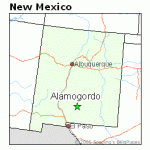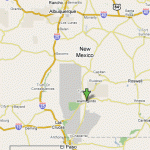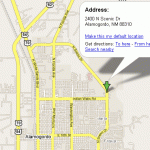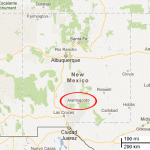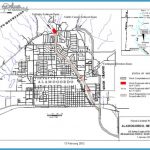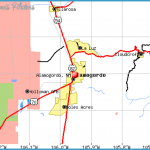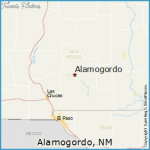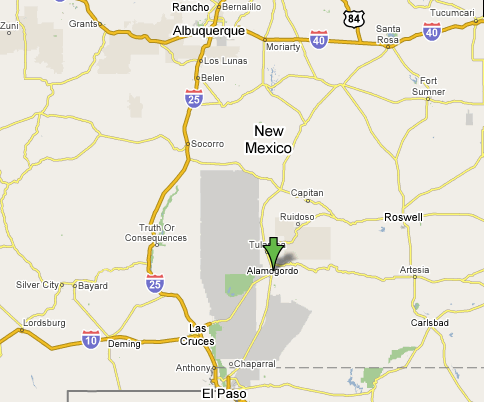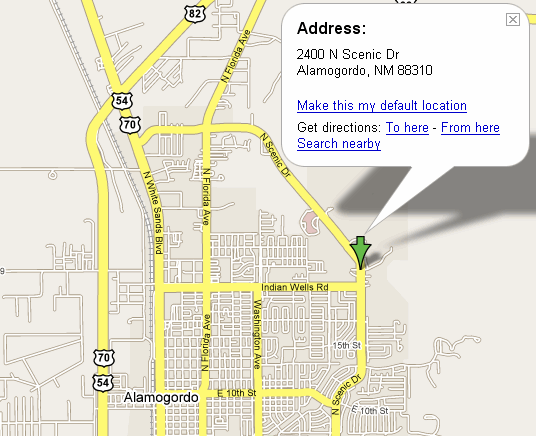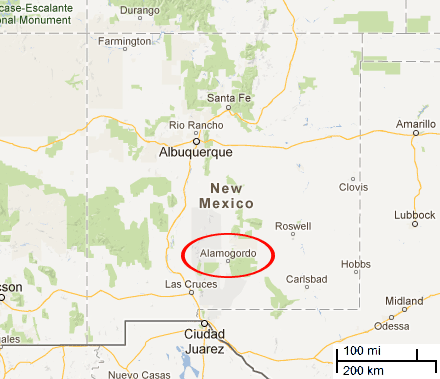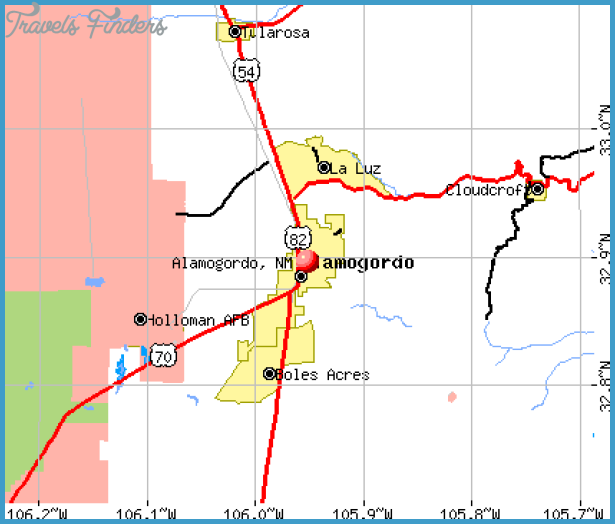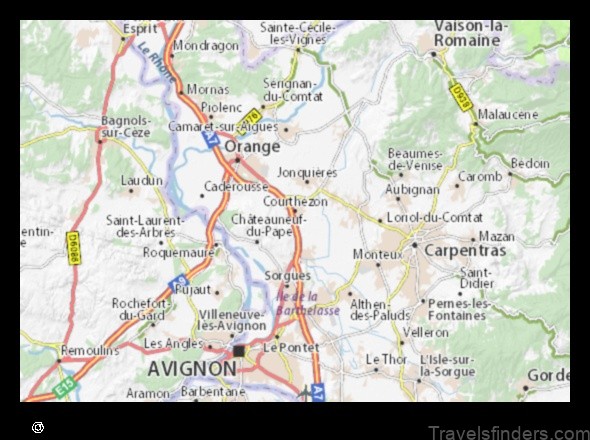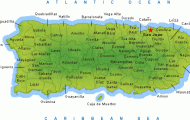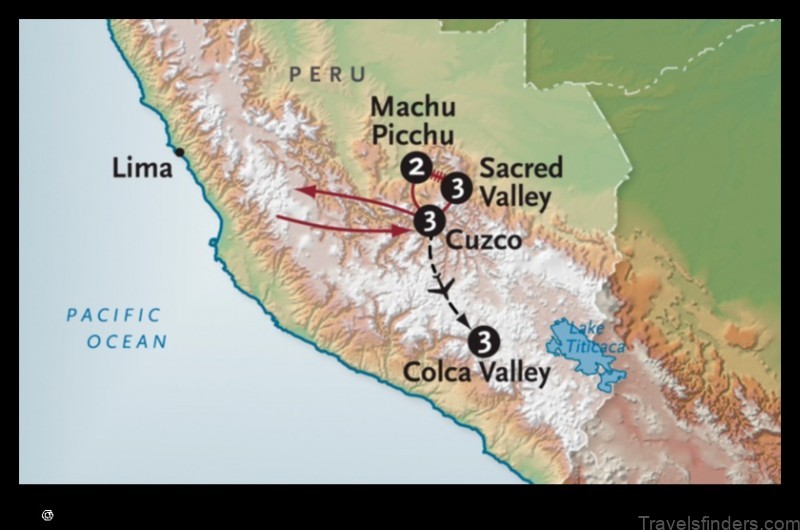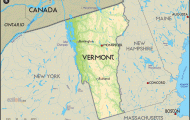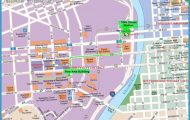White Sands Missile Range, Alamogordo
The largest military installation in the country and site of the world’s first atomic bomb explosion, White Sands is a must-see destination on any tour of the Top Secret Government. After World War II, White Sands is where captured German V-2 missiles were launched and the first American rocket weapons systems were developed and tested. Today White Sands continues to be the prime test and development facility for smaller rockets (typically air-launched missiles) and many other secret weapons systems. NASA also uses White Sands for many civilian space projects. Rumors persist that operational but still-secret Stealth aircraft are based here. This is site #4 in Top Secret America that’s larger than Rhode Island.
If Los Alamos can be considered the birthplace of the Top Secret Government, then White Sands Missile Range (WSMR) is where it came of age. White Sands was the first really large area (over 3,200 square miles) to be occupied by the Top Secret Government, and it’s still the largest military installation in the country. This is where the Top Secret Government tested the world’s first atomic bomb on July 16, 1945. It was later used for the first military rocket launches (initially using captured German V-2 missiles) as well as research into stealth technology. And secret stuff is still going on here 60 years later.
Alamogordo New Mexico Map Photo Gallery
Prior to 1942, the area now occupied by WSMR was public land sparsely occupied by ranchers and miners. Beginning in 1942, many areas within the current WSMR were closed to the public and turned into bombing practice ranges and desert warfare training facilities. In August of that year, the U.S. Army launched the Manhattan Project to develop an atomic bomb, and a secure, isolated area was needed to assemble and test such a weapon. Its isolation and proximity to Los Alamos made the area around White Sands an ideal choice, and soon the U.S. Army Corps of Engineers was busy building the first facilities inside what was to become WSMR. The site of the first atomic bomb,
known as Trinity Site, was located a little over 200 miles south of Los Alamos. It was the site of a ranch owned by the McDonald family which the government had purchased in 1942, and the ranch buildings, such as the ranch house and barns, were used for test and assembly of the first atomic bomb. Additional land was acquired and added to the existing bombing ranges, and by 1944 the current boundaries of WSMR were established.
While the Manhattan Project was reaching a climax in July 1945, a new mission for White Sands was just beginning. Numerous V-2 missiles and components, as well as German rocket scientists (notably Dr. Wehrnher von Braun), had been captured the previous spring when Germany surrendered. A large, isolated area was needed to conduct test and development work for military rockets based on the V-2, and White Sands was the obvious choice. On September 26, 1945, the first rocket launch was conducted at WSMR. Since then, WSMR has been the main testing location for almost all of America’s short-range missiles, including the Nike family deployed in the 1960s, the Pershing missiles that targeted the USSR from West Germany in the 1980s, and the Patriot air defense missiles that are currently deployed in the Middle East. WSMR was also considered as a launch facility for the Space Shuttle, but that plan was not adopted. However, WSMR is an emergency landing site for the Space Shuttle and a flight landed there in March 1982 because of bad weather at the main landing sites in California and Florida.
WSMR continues to be used both by the military and NASA for rocket testing and development, but there is much more going on here. The Directed Energy Directorate of the Air Force Research Laboratory acknowledges it is conducting experiments with high-energy lasers and microwave beams here; such weapons, like the “death rays” of cheesy science fiction movies, could be used to destroy enemy aircraft and missiles. In fact, the most powerful laser in the world the Mid-Infrared Advanced Chemical Laser (MIRACL) is located at WSMR. (It is rumored that there are more powerful but still secret lasers being tested here.) WSMR includes numerous electronic warfare ranges for testing of new airborne weapons, and it is known that new unmanned aerial vehicles (UAVs) are undergoing development here. One good indication of the level of activity as WSMR is how often Highway 70, which runs along the south end of WSMR between Las Cruces and Alamogordo, is closed to traffic because of tests. Approximately 8,000 personnel work at WSMR. WSMR covers almost 3,200 square miles, with the north-south boundaries running over 100 miles.
What’s There: Most of WSMR is empty high desert, which is just what you want under a rocket or experimental aircraft that might suddenly crash or explode. The longest runway is Northup Strip, located about 45 miles north of the Highway 70 entrance gate. It was used by the Space Shuttle for landing in 1982. There are also numerous launch pads for various rockets. Buildings and test facilities are scattered through WSMR, linked by a network of roads closed to the public. Much of WSMR is shielded from public view by the San Andreas and Sacramento mountain ranges. The administrative and personnel support facilities are located near the main gate.
Key Facilities: The High Energy Laser Systems Test Facility, operated by the U.S. Army’s Space and Missile Defense Command, is where tests are conducted into the use of lasers to destroy incoming missiles and aircraft. The Nuclear Effects Facility is used to test for the impact of nuclear radiation, directed energy weapons (like lasers), high-energy electromagnetic pulses, high-power microwaves, and other exotic weapons on living organisms as well as military and civilian hardware, communications systems, etc.
Getting a Look Inside: The highlight of any tour of the Top Secret Government has to be a visit to Trinity Site, the spot where the first atomic bomb was tested. Currently, WSMR allows visitors to Trinity Site twice a year, usually in April and October when temperatures are moderate. Amazingly, no advance reservations are currently required. Visitors enter WSMR through the Stallion Range Center, located five miles south of Highway 380; the turnoff is about 12 miles east of San Antonio, NM. At the gate, visitors are given pamphlets about Trinity Site along with rules and regulations for visitors. You can then drive, unescorted, 17 miles to Trinity Site on a paved road. You can use a camera once you’re at Trinity Site, but not while driving to or from it.
At Trinity Site, there is a stone monument, surrounded by a chain link fence, at “ground zero” for the first nuclear blast. The crater formed by the blast has been filled in over the years, although a portion of it has been left in its original state and can be viewed through a canopy; the canopy both protects the area from erosion and visitors from still-high-levels of radioactivity. You can also see the original McDonald ranch house where the plutonium core of the first atomic bomb was assembled. The area is littered with pieces of “trinitite,” a green rock formed from silica melted and fused by the nuclear explosion. Trinitite is radioactive and can fog conventional photographic film. Naturally, you’re prohibited from taking any trinitite as a souvenir, and the same goes for any rocks, plants, or other material at Trinity Site.
If you’re not in the vicinity of WSMR when tours of Trinity Site are being conducted, you can visit the WSMR museum and “missile park” (a display of full-size missiles tested at WSMR). These are located near the WSMT main gate and are usually open from 8 a.m. to 4 p.m. Monday through Friday.
Unusual Fact: Socorro, NM, is located on the eastern side of WSMR, and was the site of a famous UFO landing case on April 24, 1964. On that date, a Socorro police officer named Lonnie Zamora was pursuing a speeding car in an isolated area south of the town. Suddenly, he heard what sounded like an explosion and observed what he later described as a blue “cone of flame” coming from the direction where he knew there was a building where dynamite was stored. Thinking the dynamite in the building had exploded, he broke off his pursuit and took a dirt road leading in the direction of the “flame” and explosion. He followed the road several hundred yards until he came to the top of a hill, where he saw something that caused him to slam on his brakes: in a ravine about 150 yards away was a white, egg-shaped object resting on four legs. And around it were two human-shaped figures in what appeared to be white coveralls.
One of the figures seemed to have heard Zamora’s car, as it turned and looked directly at Zamora and his vehicle. Thinking the figures were possibly in trouble, Zamora resumed driving toward the object and radioed the Socorro police station for assistance. (He reported a “10-40,” the code for an accident, to the Socorro dispatcher.) He descended down the hill, and as he began to rise out of the dip he heard a loud roar and saw the object rising into the sky, with a blue flame coming out of the bottom. He saw not windows or other openings on the object, but did observe what appeared to be some red lettering on the side. However, the object was too distant for him to determine what, if anything, the lettering was. Thinking the object was about to crash, Zamora stopped his car again and took shelter behind it. In- stead of crashing, the object gained altitude and flew off to the southwest, toward WSMR. Zamora continued on to the landing site, where he found “landing pad” prints in the desert sand along with scorched earth and bushes. Other officers arrived within minutes of Zamora’s call and found smoke rising from the burnt bushes. By that evening, investigators had arrived from the New Mexico State Police as well as military investigators from WSMR. Air Force investigators arrived a couple of days later. All came to the same conclusion: Lonnie Zamora had seen something extraordinary, but they were not sure what it was. The “Socorro landing” quickly became one of the classic cases in UFO lore.
Initially, Zamora thought he had seen an experimental craft from WSMR. But official Air Force investigators could find no record of any experimental military craft being tested from WSMR that day, and even the lead Air Force investigator for the incident, Major Hector Quintanilla, later wrote in a then-classified report, “There is no doubt that Lonnie Zamora saw an object which left quite an impression on him. There is no question about Zamora’s reliability. He is puzzled by what he saw and frankly, so are we. This is the best documented case on record, and still we have been unable, in spite of thorough investigation, to find the vehicle or other stimulus that scared Zamora to the point of panic.”
So Zamora saw an authentic UFO, right? Well, probably not. While there were indeed no military craft being tested at WSMR that day, it was discovered over 35 years later that NASA had been testing prototypes of the unmanned Surveyor lunar landing vehicle at WSMR on April 24, 1964. And the Surveyor vehicles (which later successfully made several landings on the moon) looked very similar to the object report by Zamora, down to the four landing legs. And NASA often used red paint on its prototype vehicles.
It now seems very likely that what Zamora observed was a Surveyor prototype undergoing tests at WSMR. It may have wandered off course and made an emergency landing, or perhaps was deliberately taken outside WSMR for launching toward WSMR airspace. So why was the Air Force unable to discover records for the Surveyor tests? As a civilian agency, NASA would not be required to furnish such information, and the presence of a Surveyor prototype outside WSMR would strongly suggest that something had gone wrong with the test, maybe something the personnel involved would prefer to keep secret to pro- tect their jobs.
In other words, poor Lonnie who was widely vilified by UFO debunkers for perpetrating a hoax was probably right all along.
Getting There: WSMR is located east of Las Cruces on Highway 70. Much of Highway 70 between Las Cruces and Alamogordo parallels WSMR and many unusual lights, etc. can be observed from there during night hours. The main gate is located about 25 miles from Las Cruces on Highway 70; exit just after mile marker 169 onto Owen Road. The main gate is three miles down Owen Road.

